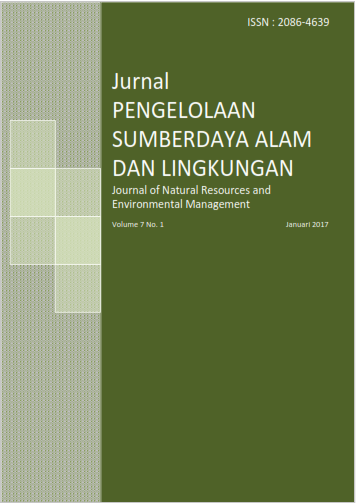ANALISIS PERTUMBUHAN TANAMAN REVEGETASI DI LAHAN BEKAS TAMBANG SILIKA HOLCIM EDUCATIONAL FOREST (HEF) CIBADAK, SUKABUMI
Abstract
The activity determines the success of reclamation is revegetation, therefore it is needed to conduct evaluation of revegetation plant growth to identify the success of post mining silica land revegetation in HEF. This research aimed to identify the status of revegetation plant growth in HEF based on spatial analysis and plant condition as well as to provide recommendation to address revegetation problems in Holcim Educational Forest. The method used by making 19 plots size of 25 m x 40 m in 4 planting blocks in HEF and conduct spatial analysis to obtain NDVI value from 2013-2016. Parameters observed were height growth, life percentage, plant health, and soil analysis. The result shows that block XI, XIII, and IX had life percentage around 82.03-86.50 and in block VII had life percentage under 80%, while the plants health in HEF block was under 80%. Spatial analysis in HEF block shows that NDVI value in HEF planting blocks increased with average NDVI 0.10. The problem occurred in HEF planting blocks was low life percentage and plants health caused by nutrient content, low pH, soil compaction, and high toxic content such as Fe, Al, and Mn.
References
Armecin, RB. Seco, MHP. Caintic, PS. Milleza, EJM., 2005. Effect of leguminous cover crops on the growth and yield of abaca (Musa textilis Nee). Industrial Crops and Products. 21, 317–323.
Daniel, T. W. Helms, J. A., dan Baker, F. S., 1987. Prinsip-prinsip silvikultur. Edisi kedua. UGM Press, Yogyakarta.
Gerson, N. D., 2007. Kondisi tanah pada sistem kaliwu dan mawar [ulasan]. Info Hutan 5 (1), pp 45-51.
Hanafiah, K. A., 2005. Dasar-dasar Ilmu Tanah. PT. Raja Grafindo Persada, Jakarta.
Hardjowigeno, S., 2003. Klasifikasi Tanah dan Pedogenesis. Akademika Pressindo, Jakarta.
Hardjowigeno, S., 2007. Ilmu Tanah. Akademika Pressindo, Jakarta.
Hasanah, NI. Wasis, B. Mansur, I., 2014. Pengembangan desmodium spp. Sebagai penutup tanah dalam reklamasi lahan pasca tambang. Jurnal Silvikultur Tropika. 5 (1), pp 7-12.
Hillel, D., 1987. Soil and Water Physical Princples and Processes. Academic Press, New York.
Husch, B. Beers, T. W. Kershaw, J. A., 2003. Forest Measuration. John & Sons, Inc, New Jersey.
Horning N. 2004. Global land vegetation; An electronic textbook: NASA Goddard Space Flight Center Earth Sciences Directorate Scientifix and Educational Endeavors (SEE). [terhubung berkala]. http://www.ccpo.odu.edu/SEES/veget/ vg_class.htm [30 Januari 2016]
Peraturan Mentri Energi Sumber Daya Mineral, 2008. Peraturan Menteri Energi dan Sumber Daya Mineral Nomor: 18 tahun 2008 tentang Reklamasi dan Penutupan Tambang. Tanggal 29 mei 2008.
Peraturan Menteri Kehutanan, 2009. Peraturan Menteri Kehutanan Republik Indonesia Nomor: P.60/Menhut-II/2009 tentang Pedoman Penilaian Keberhasilan Reklamasi Hutan. Tanggal 17 September 2009.
Peraturan Mentri Kehutanan. 2011. Peraturan Menteri Kehutanan Nomor: P.4/Menhut-II/2011 tentang Pedoman Reklamasi Hutan. Tanggal 14 Januari 2011.
Jaya, I. G. N., 2010. Analisis Citra Digital. Fakultas Kehutanan IPB, Bogor
Mansur, I., 2011. Teknik Silvikultur untuk Reklamasi Lahan Bekas Tambang. SEAMEO BIOTROP, Bogor.
Madjid, A., 2009. Dasar-Dasar Ilmu Tanah. Bahan Ajar Online. [terhubung berkala] http://dasar2ilmutanah.com/2009/04/ fisika-tanah-bagian-6 air-tanah-dan.html [20 Agustus 2016].
Megawati, NJ., 2012. Respon pertumbuhan Acacia mangium Willd terhadap penambahan kapur dan HSC (Humid Substantces Complex) pada lahan pasca tambang batubara. Tesis. Sekolah Pasca Sarjana, Institut Pertanian Bogor, Bogor.
Munawar, A., 2011. Kesuburan Tanah dan Nutrisi Tanaman. IPB Press, Bogor.
Nakhone, LN. Tabatabai, MA., 2008. Nitrogen mineralization of leguminous crops in soils. Jurna Plant Nutrtion. 171, 231–241.
Purwadhi, Sri, H., 2001. Interpretasi Citra Digital. Grasindo, Jakarta.
Rahim, F., 1995. Sistem dan Alat Tambang. Akademi Teknik Pertambangan Nasional, Banjarbaru.
Semangun, H., 2001. Penyakit-Penyakit Tanaman Holtikultura di Indonesia. Gadjah Mada University Pr, Yogyakarta.
Setiadi, Y., 2006. Teknik revegetasi untuk merehabilitasi lahan pasca tambang [terhubung berkala]. Http://pkrlt.ugm.ac.id/files/yadi setiadi.pdf [7 Februari 2016]
Setiadi, Y., 2012. Bahan Kuliah Ekologi Restorasi. Program Studi Silvikultur Tropika, Sekolah Pasca Sarjana, IPB. Tidak Diterbitkan, Bogor.
Setiadi, Y. Adinda, 2013. Evaluasi pertumbuhan pohon di lokasi revegetasi lahan pasca tambang PT. Vale Indonesia Tbk. Sorowako, Sulawesi Selatan. Jurnal Silvikultur Tropika. 4 (1), pp. 19-22.
Thomas, M. Lillesand, Ralph, W. Kiefer, 1997. Penginderaan Jauh dan Interpretasi Citra. Dulbahri, Suharsono P, Hartono, Suharyadi, penerjemah. Terjemahan dari: Remote Sensing and Image Interpretation. UGM Press, Yogyakarta.
Vissoh, P. Manyong, V. M. Carsky, J. R. Oseibonsu, P. Galiba, M., 2005. Experiences with Mucuna in West Africa. International Development Research Centre. 36
Authors
Authors who publish with this journal agree to the following terms:
- Authors retain copyright and grant the journal right of first publication with the work simultaneously licensed under a Creative Commons Attribution License that allows others to share the work with an acknowledgement of the work's authorship and initial publication in this journal.
- Authors are able to enter into separate, additional contractual arrangements for the non-exclusive distribution of the journal's published version of the work (e.g., post it to an institutional repository or publish it in a book), with an acknowledgement of its initial publication in this journal.
- Authors are permitted and encouraged to post their work online (e.g., in institutional repositories or on their website) prior to and during the submission process, as it can lead to productive exchanges, as well as earlier and greater citation of published work (See The Effect of Open Access).






